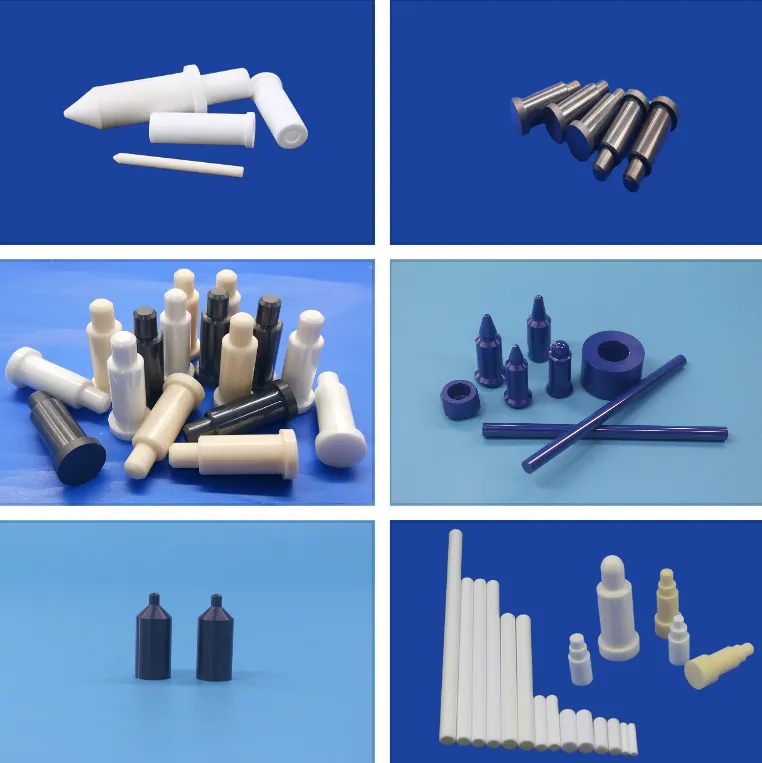Zirconia Ceramic Pins Custom ZrO₂ Zirconia Ceramic Dowel Pins Welding Pins
Product Description
Zirconia ceramic pins are cylindrical or custom-shaped ceramic parts made primarily from zirconium oxide (ZrO₂) through precision molding and high-temperature sintering. These are not ordinary pins, but rather high-tech products that leverage the unique material properties of zirconia.

Ceramic Dowel Pins, Welding Pins, and Guide Pins
Comparison with other ceramic pins, such as alumina
|
Characteristics
|
Zirconia(ZrO₂)Ceramic Pins
|
Alumina(Al₂O₃)Ceramic Pins
|
|
Fracture toughness
|
Extremely high (≈6-8 MPa·m¹/²)
|
General (≈3-4 MPa·m¹/²)
|
|
Flexural Strength
|
Extremely high (≈800-1200 MPa)
|
Good (≈300-400 MPa)
|
|
Hardness
|
High (HRA 88-91)
|
Very High (HRA 85-90)
|
|
Wear resistance
|
Excellent (due to high toughness and hardness)
|
Excellent
|
|
Cost
|
Higher
|
Lower
|
Performance and Advantages (Why Zirconia?)
Zirconia ceramic possess a unique combination of properties among all industrial ceramics, making them particularly suitable for manufacturing pin-type parts:
1. Extremely High Mechanical Strength and Toughness (Most Prominent Feature)
Through a "phase transformation toughening" mechanism, zirconia's flexural strength and fracture toughness are significantly higher than those of other ceramics, such as alumina and silicon carbide. This means it is more impact-resistant, less prone to breakage, and more durable, effectively overcoming the brittle nature of traditional ceramics.
2. High Hardness and Excellent Wear Resistance
High surface hardness (HRA ≈ 88-91) provides excellent wear resistance and a long service life.
3. Low Friction & Self-Lubrication
The smooth surface offers a low friction coefficient and exhibits a certain degree of self-lubrication when paired with certain materials (such as metals), resulting in smooth operation and resistance to seizure.
4. Excellent Corrosion Resistance
It is highly resistant to most acids, bases, and solvents, and will never rust.
5. Electrical Insulation
It is an excellent insulator.
6. Biocompatibility
Some grades of zirconia have excellent biocompatibility and can be used in medical applications.
Main Application Areas
The excellent properties of zirconia ceramic pins have made them a shining example in the following fields:
1. Precision Instruments and Sensors:
They are used as guide shafts, pivots, insulating supports, probes, and other applications, ensuring high precision, low friction, and zero magnetic interference.
2. Semiconductor Manufacturing Equipment:
They are used as positioning pins, fixture pins, and guide pins in equipment such as wafer transfer, photolithography, and etching. Their high hardness ensures zero wear particle generation, their high purity prevents contamination, and their wear resistance ensures long-term accuracy.
3. Textile Machinery and Fiber Guidance:
They are used as godet pulleys, guide hooks, and eyelets. Their ultra-smooth surface and excellent wear resistance effectively reduce wear on high-speed polymer fibers (such as nylon and carbon fiber), significantly improving product quality and equipment efficiency.
4. Medical Devices:
They can be used in joint bearings and hinge pins for surgical instruments, leveraging their biocompatibility, corrosion resistance, and wear resistance.
5. High-Precision Molds and Fixtures:
They are used as positioning pins. Their high hardness ensures long-term wear resistance and maintains extremely high positioning accuracy. Their coefficient of thermal expansion is close to that of metal, allowing for high-precision fit.
6 Automotive Industry:
Used for insulating and wear-resistant components in sensors.
